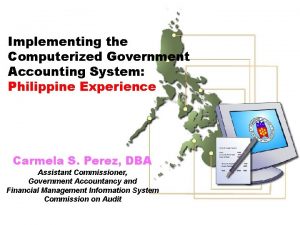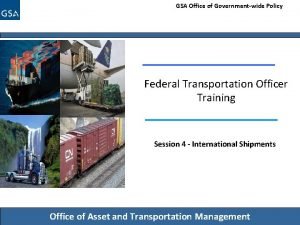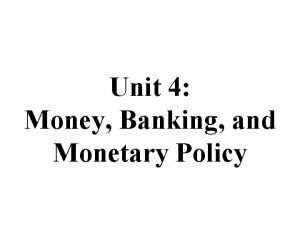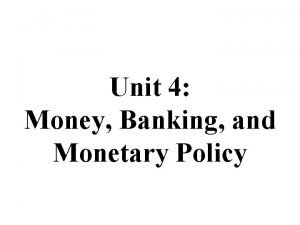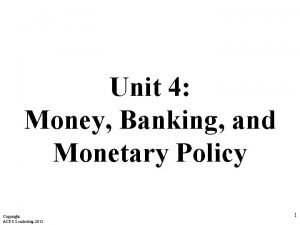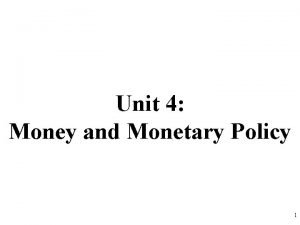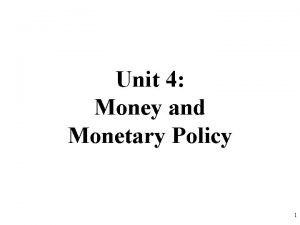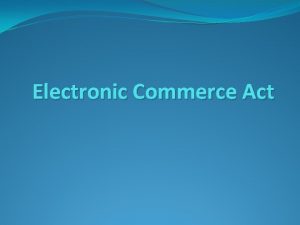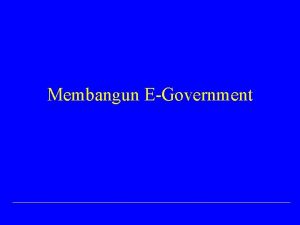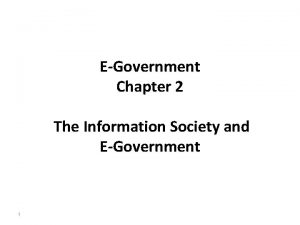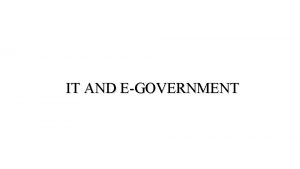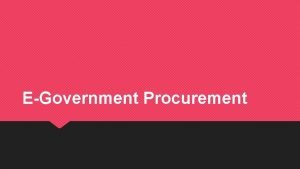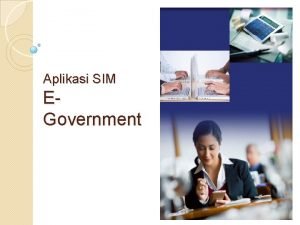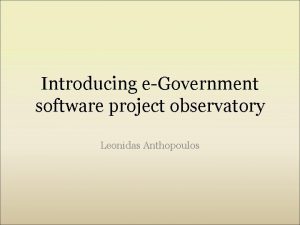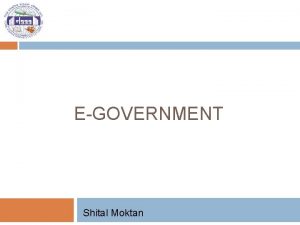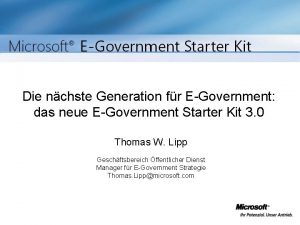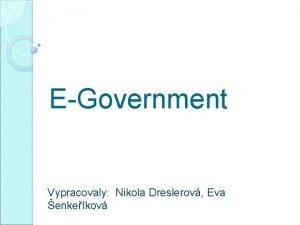Electronic Government and IT Policy Unit The EGovernment















- Slides: 15


Electronic Government and IT Policy Unit ¥ The E-Government and IT Policy Unit within the Ministry of Public Function is responsible for policymaking and co-ordination of e-Gov projects. ¥ This unit plays the most important horizontal coordination role of e-government across the federal administration: ¥ ¥ It makes e-government policies in Mexico Sets strategies and guidelines Harmonises practices and standards It works closely with the President’s Office, the e-Government Network and e-Mexico National System.

e-Government Implementation at the Agency Level ¥ Individual government offices have a great deal of responsibility with regard to e-Government implementation, although they receive guidance from the e-Government unit of the Public Function Ministry ¥ However, different possibilities exist for the implementation of e-Government. A Ministry may negotiate targets with the Presidential Office, but come up with its own strategic plan on how to reach those targets independently. It could then discuss standards for implementation with the e. Government Network.

e. Government in Mexico – Key Players Presidential Office Governmental Innovation Office Communications and Transportation Ministry Public Function Ministry E-Gov and IT Policy Unit National Science & Technology Council All IT Units at Ministry and Agency Level E-Gov Network

Federal Standards – Why? Common Solutions for Common Business Processes ¥ Program-specific decision-making to Enterprise level. ¥ Leverage commonalities in IT hosting, services and business processes operating in multiple agencies. ¥ Interface with e-Gov Common Solutions. ¥ Yield long-term cost savings and benefits through reduction of redundant investments and the establishment of a shared service environment. ¥ Resource constrained environment. ¥ Align resources with core agency mission. ¥ Improve service delivery and increase operational efficiencies.

Implementation Core Issues ¥ Change Management. ¥ Governance. ¥ Metrics/SLAs. ¥ Commercial Sector Participation. ¥ Acquisition Strategies. ¥ Financing.

Timeline Organic Law Reforms (e. Gov) Public Service Law April 2003 IT Policy & e. Governance Model) e. Document Presidental Decret Dec 2004 – January 2005 Office of the President for Government Innovation Public Function Ministry 7

e-Government and ITC Policy Decree This decree will establish the IT Governance Framework based on best-practices that will drive the Digital Government strategy in Mexico: ¥ ¥ ¥ ¥ Interoperability Organization Issues: leadership, functions, … Digital Certificate and Electronic signature Business Process & Corporate Architecture Telecommunications Outsourcing & Shared Services Privacy and Transparency Electronic Service Implementation & Multi-channel delivery Budget and Financing Security Inter-jurisdictional cooperation IT Planning and Portfolio Management Acquisitions and contracting of IT services and procurement Systems Auditing.

e. Gov & IT Governance Model Strategic Council Secretariat Advisory Council CIO Council (e. Gov Network) Technical Committees

Governmental IT Framework Web Services Architecture / Conceptual Model ●Service Delivery ●Data ●Transaction Service 1 + Service 2 + Service 3 e. Economy Basic Framework XML e. Health Citizen Portal www. gob. mx e. Learning Resources Integral Platform J 2 EE Platform Resource Admin Web. Service Development Publishing Workflow Web. Services . Net Platform CORE Platform IT Architecture Contents Campaigns Publicity Federation Security Gateway Service 1 Service 2 Gateway Service 3 Users Federation gateway Agency A Agency B Agency C Users DB A Users DB B Users DB C Identity Authenticity 10

VPN Agency n+2 VPN Agency n+1 VPN Agency n VPN Agency 2 EOF 4 - Governmental Federal Network VPN Agency 1 VPN/MPLS SP B VPN/MPLS SP A

Standardization Efforts in Mexico ¥ Electronic Operations Framework ¥ ¥ Where to Start? Trend or Reality? : ¥ ¥ Fact: OSI Layers had mixed and interweave. How to achieve smooth cross agency Interoperability startup? Key solutions (Phase 1) ¥ Set robust communication infrastructure ¥ Governmental Federal Network. ¥ Challenge: Improve resource usage, triple play (voice, data, video) ¥ Constraint: Time and budget. ¥ The solution needed creativity and legitimation. ¥ Share Knowledge and Information adopting: ¥ Federal Taxonomy Standard, Federal Metadata Standard. Evolution (Future) ¥ u. Citizen (Ubiquitous Citizen), every where, every time.

EOF 8 ¥ Share Knowledge and Information adopting: ¥ ¥ ¥ Federal Taxonomy Standard Federal Metadata Standard Portal Homologation Guidelines

EOF 8 - Roadmap

Jose Manuel Diaz jdiaz@funcionpublica. gob. mx Public Function Ministry Thank You 15
 Electronic news gathering and electronic field production
Electronic news gathering and electronic field production Is the electronic exchange of money or scrip
Is the electronic exchange of money or scrip Jev government accounting
Jev government accounting Philippine government electronic procurement system
Philippine government electronic procurement system Gsa office of governmentwide policy
Gsa office of governmentwide policy Andrew youngson
Andrew youngson National government vs federal government
National government vs federal government Unit 6 review questions
Unit 6 review questions Unit 4 money banking and monetary policy
Unit 4 money banking and monetary policy Unit 4 money banking and monetary policy
Unit 4 money banking and monetary policy Monetary and fiscal policy interactions activity 5-5
Monetary and fiscal policy interactions activity 5-5 Aggregate supply shifters
Aggregate supply shifters Unit 3 aggregate demand aggregate supply and fiscal policy
Unit 3 aggregate demand aggregate supply and fiscal policy Unit 4 money and monetary policy
Unit 4 money and monetary policy Unit 4 money and monetary policy
Unit 4 money and monetary policy Unit 4 money and monetary policy
Unit 4 money and monetary policy


